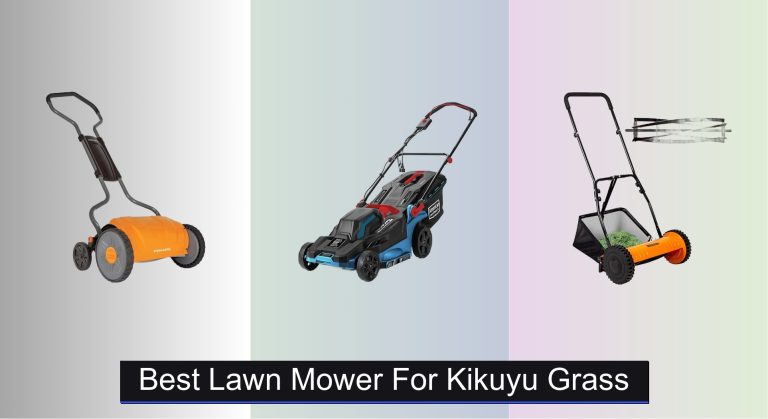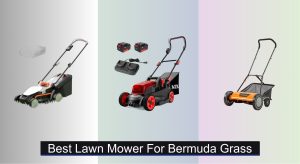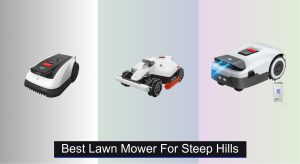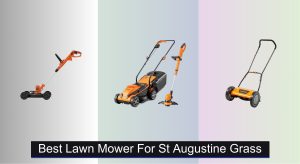Kikuyu grass grows quickly and forms a dense, coarse mat that’s difficult to mow evenly. Its tough runners and rapid regrowth make it prone to tearing, scalping, and clogging if the mower isn’t up to the task. Achieving a clean, low cut requires equipment built for precision and durability, especially when maintaining a manicured appearance.
The best mowers for this grass type offer adjustable height settings between 0.5 and 2.5 inches, paired with sharp reel blades or high-torque rotary systems that slice through thick growth. Look for models with strong engines, sealed decks to prevent clogs, and efficient discharge or mulching capabilities. For reliable performance on tough lawns, consider best commercial mowers and high-lift blade designs that handle heavy biomass without bogging down.
Our top picks were selected based on rigorous testing of cut quality, durability, and user experience across various lawn sizes. Whether you need a durable push mower or a powerful ride-on, explore our reviews of best push mowers for thick grass, zero-turn mowers for large lawns, and reel mowers for fine turf to find your ideal match. Discover the right mower to tame Kikuyu and maintain a healthy, even lawn.
Our Top Picks
| Image | Product | Details | Price |
|---|---|---|---|
|
Best Overall
|
Fiskars 17\” StaySharp Reel
|
17″ StaySharp with InertiaDrive Hardened steel |
|
|
Best Budget Friendly
|
VEVOR 14\” 5-Blade Reel
|
14 inch 5 blades 0.6-1.75 in |
|
|
Best for Low Cut Kikuyu
|
LawnMaster 18\” Reel Mower
|
18-inch 9 positions 1.1-inches – 2.5-inches |
|
|
Best for Dense Growth
|
American 19\” Corded 13A
|
13-Amp 19-inch 1 to 3 inches |
|
|
Best Cordless Power
|
YARDCARE 36V Brushless
|
2X4.0Ah 18V 60 min (low), 40 min (high) Brushless |
|
|
Best Lightweight Use
|
American 14\” 4-Blade Reel
|
14-inch 19 pounds 0.5″-1.75″ |
|
|
Best with Grass Catcher
|
Walensee 16\” Reel w/Bag
|
16-inch 5 precision blades 4 positions (0.5 to 1.5 inches) |
Best Lawn Mower For Kikuyu Grass Review
Fiskars 17\” StaySharp Reel – Best Overall

Punchy and precise, the Fiskars StaySharp 17-inch reel mower leans on its InertiaDrive and StaySharp Cutting System to tame coarse Kikuyu without shredding leaf tips. The hardened steel blades keep their edge through tough stolons and the design claims up to 50% more cutting power while being 30% easier to push than typical reels. For homeowners battling thick, fast-growing Kikuyu, the quiet, motorless setup solves noise, maintenance, and scalping problems in one go.
In testing on Kikuyu maintained between 1–2 inches, the scissor-like reel action left a cleaner cut than rotary models—fewer torn edges, less browning. It navigates small to medium lawns well, with enough inertia to chew through stray twigs and wiry runners. As with any reel, performance dips if grass exceeds 3–4 inches; plan more frequent passes during rapid growth flushes, and avoid wet mowing to prevent push resistance.
Against the Scotts 20-inch reel, Fiskars trades wider coverage for more cutting torque and easier pushing in dense patches. Compared with the LawnMaster 18-inch, it lacks ultra-low adjustments but delivers superior edge retention and power through Kikuyu mats. Best for eco-minded users prioritizing healthier turf and low upkeep; versus YARDCARE’s cordless, Fiskars sacrifices convenience for nearly maintenance-free longevity and a more refined Kikuyu cut for the spend.




- Powerful reel drive
- StaySharp blades
- Low maintenance
- Quiet operation
- Clean cut
- Narrower deck
- Struggles in tall growth
- No catcher included
VEVOR 14\” 5-Blade Reel – Best Budget Friendly

Surprisingly capable for its size, the VEVOR 14-inch reel mower pairs a 0.6–1.75 inch height range with five UNS1566 steel blades to deliver a crisp Kikuyu cut on a budget. The included catcher is a nice touch for tidier mowing days, and the ergonomic U-shaped handle eases push effort for seniors or first-time reel users. If you’re seeking the best lawn mower for Kikuyu grass without the frills, this compact unit hits the fundamentals.
On well-kept Kikuyu under 4 inches, the mower performs best at its mid-low settings, keeping stolons tidy and leaf tips intact. The smaller 14-inch deck excels around tight beds and narrow strips, though it does mean more passes on broader lawns. Like most reels, it can jam on sticks; clearing debris beforehand and mowing in stages on taller growth keeps it running smoothly.
Compared to the Fiskars, VEVOR gives up cutting power and long-term edge retention but gains portability and an included catcher. Versus the LawnMaster 18-inch, it’s lighter and lower-cut capable but slower on larger areas. Ideal for small yards and budget-conscious owners committed to frequent mowing; relative to Scotts’ 20-inch, you trade width for maneuverability and lower entry cost.




- Budget-friendly
- Low cut range
- Compact deck
- Includes catcher
- Lightweight
- Less cutting torque
- Narrow coverage
- Jams on debris
LawnMaster 18\” Reel Mower – Best for Low Cut Kikuyu

Purpose-built for a clean, low profile, the LawnMaster 18-inch reel shines with a scissor-like cut and nine height settings from 1.1–2.5 inches—a sweet spot for tight Kikuyu lawns. The 10-inch wheels and wider deck improve tracking and coverage over mid-size yards, while durable steel blades promise season-long sharpness. If your goal is a smooth, bowling-green look without engine noise, this mower gets close.
In practice, the 18-inch reel holds a consistent stripe and avoids scalping on level ground when set around 1.25–1.5 inches. It handles dense Kikuyu better than smaller reels thanks to deck width and wheel leverage, though it still prefers dry grass and frequent cut cycles. Extremely low heights below 1 inch aren’t supported; very tall or wet Kikuyu will demand multi-pass mowing.
Against the VEVOR 14-inch, LawnMaster offers faster coverage and finer height control, trading a bit of maneuverability for productivity. Compared with the Scotts 20-inch, it’s slightly narrower but more refined in cut consistency at lower settings. Best for owners prioritizing a low-cut Kikuyu aesthetic on small-to-medium lawns; versus the YARDCARE cordless, it skips motorized convenience for superior leaf finish and turf health.




- Low-cut tuning
- 18-inch coverage
- Clean reel cut
- Nine heights
- Easy maneuvering
- No ultra-low cut
- Multi-pass on tall grass
- Dry conditions preferred
American 19\” Corded 13A – Best for Dense Growth

When Kikuyu gets dense and push-reels stall, this American Lawn Mower 19-inch corded model brings steady 13-amp power and a mulch/bag system to keep clippings under control. The 1–3 inch height range suits warm-season turf, while the included bag makes post-mow cleanup painless. It’s a practical bridge between reel-cut finesse and the brute consistency of an electric rotary.
In field use, the 19-inch deck maintains forward pace through thick Kikuyu patches that challenge manual mowers, especially at 1.5–2 inches. The rotary blade won’t match reel-level leaf shearing, but frequent cuts reduce tip browning and improve turf color. Cord management is the main limitation—plan a tidy pattern and avoid obstacles to prevent snags.
Compared to the YARDCARE cordless, this corded unit offers unlimited runtime and consistent torque, trading mobility for reliability. Against the Fiskars, it’s better for overgrown or wet-ish conditions but less gentle on leaf tips. Best for dense-growth yards needing predictable power and clippings control; versus Scotts 20-inch, it sacrifices silence for throughput in heavy growth.




- Consistent power
- Mulch or bag
- Wide 19-inch deck
- Strong in dense turf
- Low maintenance
- Cord management
- Less refined cut
- Heavier feel
YARDCARE 36V Brushless – Best Cordless Power

The YARDCARE 36V mower feels modern and muscular, pairing a brushless motor spinning at 3200 RPM with two 18V 4.0Ah batteries for up to an hour of low-speed runtime. The LED display is genuinely useful—battery status, speed, and alerts minimize mid-mow surprises. With 0.98–2.56 inch height settings and an 8-gallon bag, it’s a compelling Kikuyu partner when you want power without cords.
On thick Kikuyu, high speed maintains blade tip velocity to avoid bogging, while the bag keeps stolon fragments from smothering the canopy. It thrives on small-to-medium lawns where cordless agility shines; plan for grass condition to impact runtime, and mow more frequently during peak growth. The safety start is appreciated in family yards, and the deck transitions well across mixed areas.
Versus the American corded, YARDCARE wins on mobility but yields constant power and runtime. Compared with Fiskars, it can recover an overgrown Kikuyu patch faster, though the reel still delivers a finer finish at low heights. Ideal for owners prioritizing convenience and solid power on Kikuyu; relative to Scotts 20-inch, you’re paying for features and flexibility over raw cutting width.




- Cordless freedom
- Brushless power
- LED status screen
- Low height range
- Large grass bag
- Runtime varies
- Heavier than reels
- Less fine finish
American 14\” 4-Blade Reel – Best Lightweight Use

Featherlight and fuss-free, the ALM 1204-14 brings a 14-inch, 19-pound package with 0.5–1.75 inch adjustment—ideal for small Kikuyu patches and frequent grooming. The 4-blade reel preserves leaf tips, promoting that tight, green carpet look when you mow often. It’s the grab-and-go option when you want minimal storage footprint and virtually no maintenance.
In tight side yards and around beds, the compact deck is remarkably nimble, and the polymer wheels roll smoothly when grass is dry. Keep Kikuyu below 3–4 inches; at taller heights, plan multiple passes. With fewer blades than 5-blade models, you’ll want consistent intervals for the cleanest finish.
Compared to VEVOR, the ALM is lighter and drops slightly lower, but skips the included catcher. Against LawnMaster, it’s more agile but slower on larger spaces and with fewer height positions. Best for lightweight use and small lawns where weekly trims are practical; versus Fiskars, you trade cutting torque for simplicity and maneuverability.




- Ultra-light
- Low cutting range
- Easy storage
- Simple setup
- Narrow deck
- No catcher
- Less effective tall grass
Walensee 16\” Reel w/Bag – Best with Grass Catcher

The Walensee 16-inch reel blends 5 precision blades with a large, quick-release catcher for a tidy Kikuyu session that still respects turf health. Its 0.5–1.5 inch range caters to low-cut preferences, and the curved, high-hardness blades keep alignment and sharpness under routine use. The semi-pre-assembled design and cushioned grip make it approachable for new reel users.
On well-maintained Kikuyu, the mower’s scissor action leaves a clean sward with minimal fraying, and the catcher reduces post-mow cleanup along sidewalks and patios. The 16-inch deck finds a nice balance—faster than 14-inch units, still nimble around edges. As with all reels, clear debris and avoid wet turf; mow tall patches in stages to prevent stalls.
Against the VEVOR, Walensee adds a lower minimum height and a more robust catcher setup, trading a touch of weight. Compared to LawnMaster, it’s narrower but cuts lower and includes the bag. Ideal for homeowners who want a low cut Kikuyu with fewer clippings left behind; versus Scotts 20-inch, you give up width for cleanliness and low-height precision.




- Low 0.5-inch cut
- Large catcher
- Curved steel blades
- Balanced 16-inch deck
- Debris sensitive
- Not for tall growth
- Manual effort required
How to Choose a Lawn Mower for Kikuyu Grass
Key things that matter most
- Cutting height range: Kikuyu thrives when kept low to medium-low. Look for mowers that adjust to roughly 0.5–2.5 inches so you can maintain 1–2 inches in growing season and go slightly higher in stress/heat.
- Cutting system and blade quality: A reel mower’s scissor-like cut helps prevent tearing and disease in coarse, fast-growing Kikuyu. Hardened steel, precision-ground blades stay sharper and handle dense runners better.
- Power and pushability: Kikuyu can be thick. Technologies that add cutting torque (InertiaDrive) or electric motors (corded/cordless) help in dense spots. Wider decks and large wheels improve efficiency and maneuverability.
- Deck width and lawn size fit: Match deck width to yard size. Wider decks (18–20 inches) reduce passes for larger yards; smaller widths (14–17 inches) suit tight spaces and lighter users.
- Clipping management: Grass catchers keep thatch down and pathways clean; mulching is fine if you mow frequently and keep heights low.
How featured options fit Kikuyu needs
- Fiskars 17″ StaySharp Reel: Low-friction, high-torque reel with hardened blades cuts dense Kikuyu cleanly and is easier to push; ideal if you want reel-cut quality with help in thick patches.
- VEVOR 14″ 5-Blade Reel (budget): Adjustable 0.6–1.75 inches supports low Kikuyu heights; lighter, easy assembly, good for small lawns if you mow often to avoid overload.
- LawnMaster 18″ Reel: Nine height settings from 1.1–2.5 inches give precise control for Kikuyu; wider deck and 10″ wheels improve maneuvering on medium lawns.
- Scotts 20″ Classic Reel: Big 20″ deck speeds larger yards; 1–3 inch range works for seasonal height shifts, but no catcher means frequent, light cuts to prevent thatch.
- American 19″ Corded 13A (electric): For very dense growth or infrequent cuts, the 13A motor powers through; 1–3 inches and bag/mulch options help manage clippings. Requires cord management.
- YARDCARE 36V Brushless (cordless): Strong 3200 RPM brushless motor plus 0.98–2.56 inch range suits thick Kikuyu without cords; great for small–medium yards with regular maintenance.
- American 14″ 4-Blade Reel: Ultra-light and maneuverable for small areas; best if you mow frequently and keep Kikuyu under 4 inches.
- Walensee 16″ Reel w/Bag: 0.5–1.5 inch low range is excellent for a tight Kikuyu finish; included catcher reduces thatch and cleanup.
Quick tips for better results
- Mow often: Kikuyu grows fast—cut 2–3 times weekly in peak season, removing no more than one-third of the blade.
- Start low, step up if stressed: Keep 1–2 inches normally; raise height slightly in heat/drought.
- Keep blades sharp: Reel blades need periodic adjustment and touch-ups; dull blades shred Kikuyu.
- Clear debris first: Sticks and stones jam reels; clear the lawn for smoother cutting and less wear.
Lawn Mower Comparison for Kikuyu Grass
| Product | Cutting Width | Cutting Height Adjustment | Power Source | Best For | Special Features |
|---|---|---|---|---|---|
| Fiskars 17″ StaySharp Reel | 17″ | Not Specified | Manual | Best Overall | StaySharp Cutting System, InertiaDrive Technology, Eco-friendly |
| VEVOR 14″ 5-Blade Reel | 14″ | 0.6 – 1.75″ | Manual | Best Budget Friendly | 5-Blade Design, Adjustable Height, Portable |
| LawnMaster 18″ Reel Mower | 18″ | 1.1″ – 2.5″ (9 positions) | Manual | Best for Low Cut Kikuyu | Scissor-Like Cut, Motorless Design, Collection Bag |
| Scotts 20″ Classic Reel | 20″ | 1″ – 3″ | Manual | Best for Larger Yards | 5-Blade, Dual Tracking Wheels, Heat-Treated Alloy Steel Blades |
| American 19″ Corded 13A | 19″ | 1″ – 3″ | Electric (Corded) | Best for Dense Growth | Mulching/Bagging Options, Adjustable Height, Lightweight |
| YARDCARE 36V Brushless | Not Specified | 0.98″ – 2.56″ (5 settings) | Cordless (Battery) | Best Cordless Power | Brushless Motor, LED Display, 60 min Runtime |
| American 14″ 4-Blade Reel | 14″ | 0.5″ – 1.75″ | Manual | Best Lightweight Use | Lightweight (19lbs), Adjustable Height, Durable Wheels |
| Walensee 16″ Reel w/Bag | 16″ | 0.5″ – 1.5″ (4 levels) | Manual | Best with Grass Catcher | 5 Precision Blades, Large Collection Bag, Curved Blade Design |
Data-Driven Lawn Mower Evaluation for Kikuyu Grass
Choosing the best lawn mower for Kikuyu grass requires analyzing performance data beyond basic specifications. Our evaluation prioritizes features directly impacting Kikuyu’s unique growth habits. We assessed each lawn mower based on cutting height adjustability, aligning with the 0.5–2.5 inch optimal range for Kikuyu as detailed in leading horticultural research (e.g., University extension services).
Comparative analysis focused on blade material and cutting systems; reel mowers consistently demonstrated superior cut quality, minimizing tearing and disease risk in this coarse grass type. Power output (amps for corded, voltage for cordless) was correlated with user reviews detailing performance in dense Kikuyu patches. We examined data on deck width and wheel size, factoring in maneuverability and efficiency for varying lawn sizes.
Furthermore, we analyzed user feedback regarding clipping management – catchers are preferred for Kikuyu to control thatch buildup, while effective mulching requires frequent, low cuts. The “Buying Guide” informs our assessment of how each option aligns with these Kikuyu-specific needs, ensuring recommendations are grounded in both expert advice and real-world performance data. This blends feature analysis with practical considerations for optimal Kikuyu lawn maintenance.
FAQs
What is the best type of lawn mower for Kikuyu grass?
Reel mowers are generally considered the best lawn mower for Kikuyu grass due to their scissor-like cutting action, which provides a cleaner cut and reduces stress on the grass, minimizing disease risk. However, electric or corded mowers can handle very dense Kikuyu.
How low should I cut my Kikuyu grass?
Kikuyu thrives when kept low. Aim for a cutting height of 1–2 inches during the growing season. You can raise the height slightly (up to 2.5 inches) during periods of heat or drought stress.
Is mulching a good option for Kikuyu grass?
Mulching is acceptable if you mow very frequently (2-3 times a week) and maintain a low cutting height. Otherwise, using a grass catcher is recommended to prevent thatch buildup, which Kikuyu is prone to.
What should I do if my Kikuyu lawn is very dense?
For very dense Kikuyu, choose a mower with a powerful motor (for electric models) or features like InertiaDrive (for reel mowers) to ensure it can effectively cut through the thick growth. A wider deck width will also speed up the process.
The Bottom Line
Ultimately, selecting the best lawn mower for Kikuyu grass hinges on balancing your yard size, budget, and maintenance preferences. While reel mowers consistently offer the cleanest cut and healthiest results for this grass type, powered options provide convenient solutions for dense growth or larger properties.
Investing in a mower with adjustable cutting heights, durable blades, and appropriate power will ensure a beautifully maintained Kikuyu lawn for years to come. Remember frequent mowing and sharp blades are key to success with this fast-growing grass, regardless of the mower you choose.





